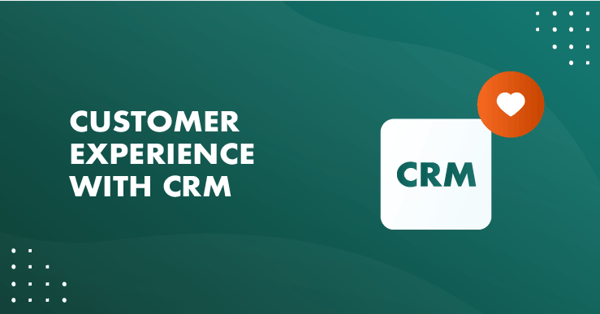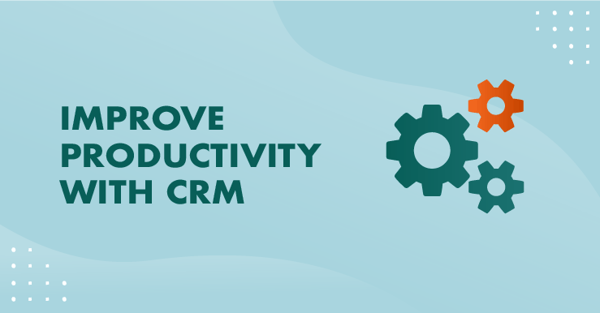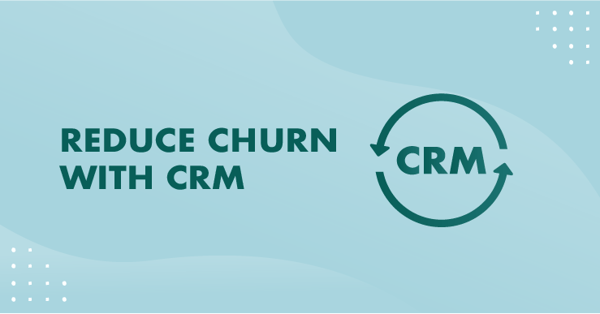Table Of Contents
When it comes to setting revenue targets, we usually start with net new business - i.e. new business deals with new customers.
But have you thought about how you can maximize the revenue earned from your existing customers, too?
With at least 65% of a company’s revenue coming from existing customers, it’s important for you to consider how much of an impact selling more to these existing customers could have on your bottom line.
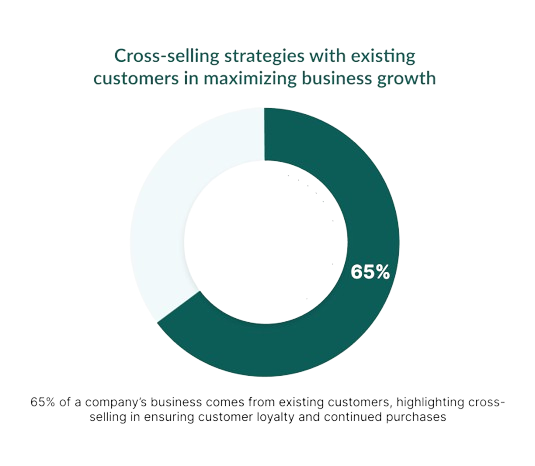
Couple this with the fact that your existing customers are 50% more likely to spend more money with you and spend 31% more on average than new customers - you could be missing out on a huge revenue generation opportunity.
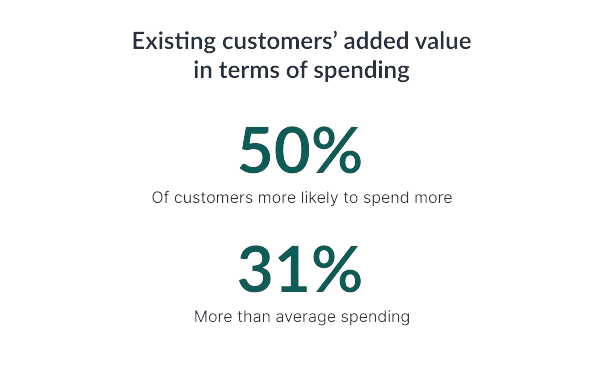
But how do you get started selling more to your existing customers?
In this guide, we’re going to cover 4 ways you can use your CRM system to help you sell more to your existing customers.
First up … it’s time to get personal.
Creating personalized marketing campaigns
As a customer-facing professional, you know that every customer wants to feel like they’re special and unique.
But did you know that you can use your CRM to turn making customers feel special into additional revenue?
That’s where personalization comes in.
With 88% of customers believing that the experience a company provides is just as important as the produce or services you offer - it’s clear that experience matters.
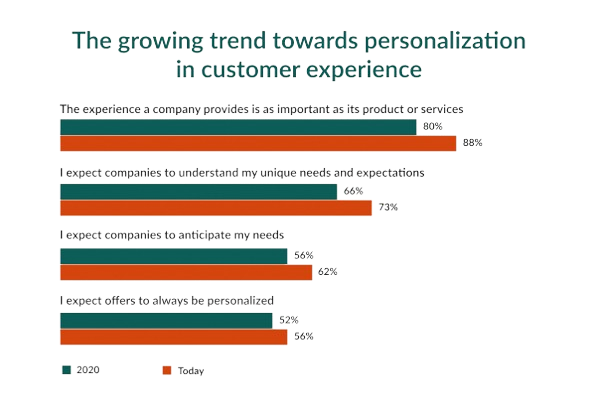
So it’ll come as no surprise when we tell you that personalization is one of the biggest growing trends in customer experience - and one you should be making the most of!
Research shows that 73% of customers expect companies to understand their unique needs and expectations.
Meanwhile, a further 62% expect companies to anticipate their needs - and at least 56% of customers expect that any offers they receive should always be personalized.
Personalization is about much more than just putting someone’s name in an email - at its heart, it’s really an exercise in using the data you already have to your advantage.
So, how do you start creating personalized marketing campaigns in your CRM?
Choose what to sell
The first thing you need to do is think about what is it you want to sell to your existing customers. Is it more licenses? Additional services? Perhaps even a different product in your range. Whatever it is you choose, you need to be very clear on what it is you want to offer through a personalized marketing campaign.
Who is most likely to buy your offer?
Personalized marketing doesn’t mean you have to send individual campaigns to each one of your customers.
You simply need to put the right offer in front of the right group of customers.
Take some time to think about who is most likely to buy this specific offer you’re working on and what characterizes that group of customers.
You may need to look at historic sales data to understand the types of customers who have previously purchased a specific upsell or cross-sell.
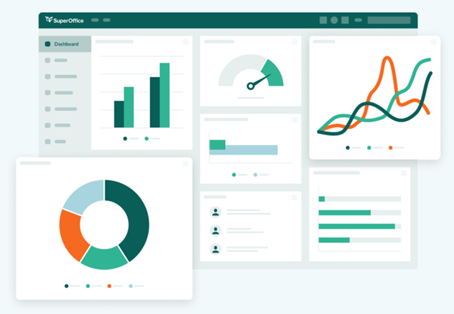
SuperOffice CRM dashboards give you easy access to all your sales, marketing, and service data points
Think about what these customers have in common - it could be size, location, length of tenure as a customer, or even specific products or features they already use.
Whatever common characteristics you discover about previous purchases, use this information to develop an ideal customer profile or ICP for this offer.
Segment your customer data
Once you know what you’re selling and what your ideal customer profile looks like, it’s time to look for existing customers who fit against your chosen criteria.
This is a process known as data segmentation - and using a CRM it’s nice and easy.
Simply search your customer base using an inbuilt tool in your CRM - such as SuperOffice’s Selections feature - to segment by the size of companies, roles, contact types, purchase history, and more.
Create a compelling offer
By this point, you’ll have established what you’re selling and who you’re selling it to.
So the time has come to create a compelling offer for your segmented customer list and an email campaign to support it.
3 examples of compelling personalized offers you might consider include:
Product Training - if you’ve identified a group of customers who have recently bought software licenses for a number of new users - then you can develop a training offer to both meet their needs and boost your revenue.
You can frame the offer around celebrating the customer’s recent successful growth (adding more users), as well as your understanding of the need to get those users up to speed and efficient as soon as possible - presenting training as the solution to help them maximize the impact of their new software licenses.
Product Add-ons - If your target segment already uses your core SaaS product, but you know that because of their size and scale, they’re going to be interested in your latest ‘Data Warehousing’ add-on, then you can produce an offer based on this information that’ll be sure to increase sales.
By focusing on the data you already have about the customer’s size and current product usage, you can build a compelling offer that’ll resonate with their need to make better use of the data they’re producing in your software as part of wider data initiatives across their organization.
Equipment Upgrades - Perhaps the customers you’re focused on have been customers for a while, and they’re due an upgrade on their manufacturing equipment. Targeting these customers with an offer ensures not just an increase in revenue - but also further retains them as customers for the long term.
By focusing on the time they’ve been a valued customer and how much more efficient manufacturing equipment is now, you can align their long-term growth aspirations with the introduction of an even better version of what they’ve already got - that’ll help them to supercharge the next phase of their business.
One of the easiest ways to get started is to use SuperOffice’s inbuilt AI features.
Using artificial intelligence to make suggestions for your campaign enables you to save a significant amount of time and concentrate instead on simply adding the finishing touches.
However, if you’d prefer to write your email campaign manually, SuperOffice can support that, too - with an email campaign editor that gives you granular levels of editorial control.
Send via your CRM
Once you’ve written your email campaign - now it’s time to send it.
As with all steps to this point, you can do this using your CRM system, too.
To give you an insight into how you can send your personalized email marketing campaigns to your customers using SuperOffice, we’ve included a video:
Track & follow up via your CRM
As a sales professional, it won’t surprise you to hear that 80% of sales require 5 follow-up calls in order to close the deal.
Unfortunately, this probably won’t be too different, even with your personalized marketing campaign - so you’ll still need to follow up with your prospects to keep your offer front of mind for them.
As with all deals in your pipeline, you can track everything and schedule follow-up calls from within your CRM software.
Account Planning & Customer Success
Sales shouldn’t end when the initial contract is signed - in fact, that should only be the beginning of your business relationship with the customer.
To help you consistently achieve profitable growth, you’ll need a strategy in place to sell to your existing customers, too.
However, it’s important that any sales efforts aimed at existing customers are done in the right way - otherwise, you risk alienating them!
This is because customers are put off by what they perceive as ‘high-pressure’ sales tactics - preferring to do 95% of the fact-finding and information gathering themselves - before engaging with a sales rep.
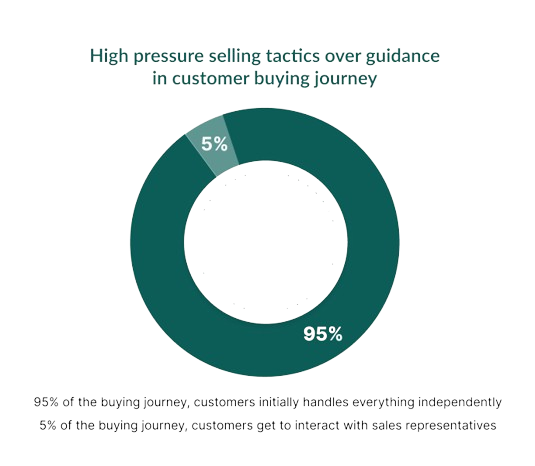
There are two main tactics you can use to navigate around this risk and add ongoing value for your customers, both of which can be done using your CRM.
Account Planning
Put simply, account planning is all about recording all the relevant details for either a new or existing customer and determining your approach to how you’re going to generate revenue from that customer.
For existing customers, the account plan will look more closely at retention strategy as well as identify opportunities to increase the amount of money they spend with you through upsells, cross-sells, and natural account expansion.
To help kickstart your account planning approach, you can record all the relevant data about your customers in your CRM and use it as a central source of the truth to keep everyone across the plan for specific customers.
Still not sure about how account planning can help you to sell more to your existing customers? Here are 4 key benefits you can take advantage of right away:
- Build Long-Term Customer Relationships: By working more closely with your customers to understand their needs as part of an account planning process, you will inevitably be able to build much better and longer-lasting relationships with them as a result. These relationships help you not only help you get an inside track of what your customers really want - but they’re also more likely to trust your recommendations and work with you more like a partnership.
- Make Data-Driven Decisions in Advance: Because you’ll be using existing customer data all about their usage, support requests, and everything else in between - you’ll be perfectly placed to use data in your decision-making process. This makes your account-derived sales forecasts more accurate as a result.
- Deliver Value & Boost Client Retention: Working so closely with the client puts you in the perfect position to make sure that all your interactions add significant value for the customer. This, in turn, not only enables you to sell more in the short term but protects that revenue in the long term through ongoing customer retention.
Customer Success
Typically, customer success is the function - or group of processes - designed to ensure the customer continually receives value from your product in order to maintain a long-term relationship with your business.
These processes tend to follow 4 key areas during the lifetime of the customer; adoption, retention, expansion, and advocacy.
In this case, it’s the expansion phase that we’re most interested in - as it’s the phase in the customer journey where your customers are happy with your product and looking to double down on their usage.
By undertaking processes such as quarterly business reviews, success planning, or relationship management, customer success managers in your business can uncover hidden opportunities for expansion revenue from your existing customers.
As with account planning, you can also use your CRM to record relevant data over the course of your relationship with your customers, and your customer success managers can then use this data as the basis for their pursuit of expansion revenue.
While a customer success-led approach offers the same key benefits as account planning in terms of building strong relationships with customers, identifying upsell and cross-sell opportunities, making data-driven decisions, and boosting customer retention, it also offers 3 additional benefits.
- Improve Product Usage and Adoption: By working more closely with your customers, customer success teams can get a better understanding of how they’re using your product. This means that not only can they help to boost the adoption of the product but also identify gaps in their solution that could be potential upsell opportunities.
- Gather Feedback & Insights: Because your CSMs will have regular contact with your customers, they’re perfectly placed to gather feedback - that can be used to improve your product or service - and industry insights such as upcoming trends of legislation that could offer potential revenue opportunities.
- Advocacy and Referrals: The main aim of your customer success team is to create an incredible experience for your customers so that they can unlock the maximum value from your products. By ensuring that your customer experience is on point, your CSMs are going to be in a great position to create product advocates who will make personal referrals that will turn into new customers.
Upselling and cross-selling
Before we dive into these key strategies for maximizing revenue from existing customers. let’s quickly go over the difference between cross-sells and upsells:
Upsells - a natural expansion of a product or service a customer has already purchased. Examples include additional licenses or a higher tier of service.
Cross-sells - the additional sale of a product or service you offer that may complement a customer’s original purchase. E.g. signing up for a CRM subscription and then subscribing to a customer service module.
But have you heard about the impact that CRM software has on both upsells and cross-sells?
If you were on the fence about how important a CRM could be for your business, you need to think again - as the results speak for themselves.
Companies that use CRM software see a 47% improvement in both customer satisfaction and retention rates.
Meanwhile, they also benefit from a 45% increase in sales revenue and see upsell revenue levels improve by 39%.
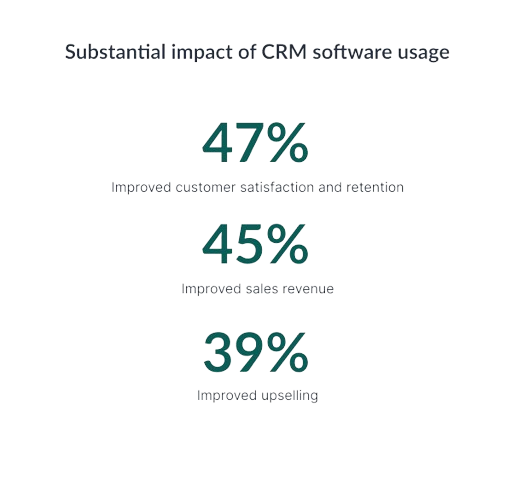
It’s not just companies who focus on upsells that see huge upsides from using a CRM, though.
Companies that perform dynamic cross-sells - using a CRM to provide them with real-time customer data - see a 20% increase in cross-sell revenue compared to those that don’t.
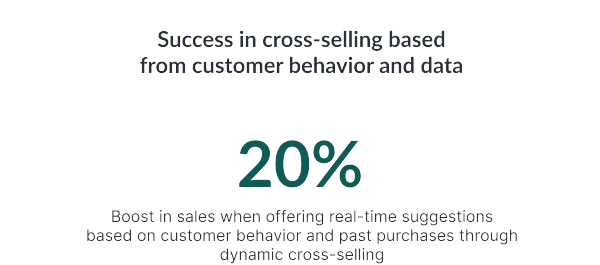
So, it means that if you’re not using a CRM system to help you with your upsell and cross-sell strategies, you’re missing out on significant additional revenue from your existing customers.
Targeting different audiences with upsells and cross-sells
In order for you to understand the best way to approach upsells and cross-sells with your customer base, you need to take a strategic approach - because one size doesn’t fit all.
- Create target personas - think about the types of upsell and cross-sell opportunities you want to offer and who they’re most suitable for. Common personas can include categories like ‘startup and small business’, ‘mid-market SMEs’, and ‘Enterprise’.
- Create ideal solutions - each category of persona will likely have different needs based on their size, budget, and growth potential. It's your job to map out which upsell opportunities and which cross-sell opportunities best align with your target personas. To start with, aim for one upsell, and one cross-sell per persona, but feel free to add more.
- Segment your customer base - now it’s time to look at your existing customer list and categorize or ‘tag’ individual customers in your CRM as one of your target personas. This will make it easy for sales and service teams to identify the appropriate initial course of action for each customer.
Asking for referrals
When it comes to generating additional revenue from your existing customers, another smart - but often overlooked - tactic is referrals.
Ok, so referrals in themselves don’t count as ‘selling more’ to your existing customers - but they’re the next best thing.
This is because a staggering 92% of customers trust referrals over any kind of marketing or advertising - making them more likely to purchase your product or service based on the recommendation they were given.
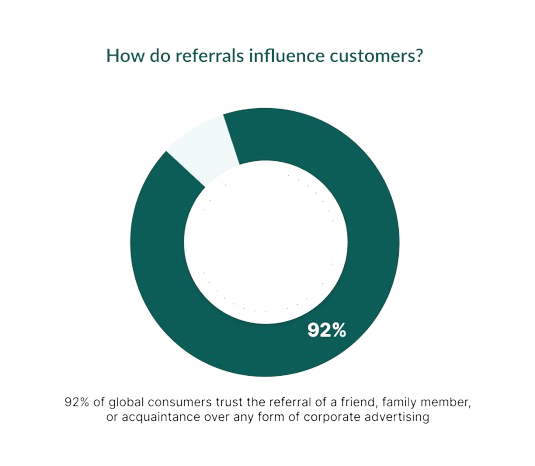
However, this word-of-mouth goldmine isn’t easy to come by.
In order for your customers to naturally want to refer your product, first of all, they need to have had an excellent experience - both with the product and the supporting service.
So, with this in mind, you’ll need to cultivate your customer relationships over time to naturally turn them into passionate advocates for your brand.
Traditionally someone who is ready to refer will score highly in a Net Promoter Score (NPS) survey.
But you can also look at call notes, sentiment analysis, and other data points in your CRM to determine which customers will be most likely to make a referral - and then use your CRM to reach out and help them with the process.
Referral email template
To help you get started with asking your own customers for a referral, we’ve prepared an email template that you can copy and paste - or adapt - to your specific needs.
Subject: "Let's Grow Together, [Customer's Name]!"
Dear [Customer's Name],
I’m reaching out to express our sincere thanks for your continued support of [Your Company Name].
We are thrilled to be working with you and are incredibly proud of what we've accomplished together.
As we look to expand our reach and impact, we recognize that the most meaningful growth often comes through recommendations from our valued customers like you.
This is where we need your help.
Would you be willing to refer us to other businesses that could benefit from our services?
Your referral is the highest compliment we could receive, and it will play a pivotal part in our growth.
To make this as easy as possible for you, here are a few points you might consider mentioning:
- The specific services/products we have provided to you.
- How our solutions have helped in addressing your needs.
- The experience of working with our team.
To refer someone, simply reply to this email with their contact information, or if you prefer, you can directly introduce us via email, and we will take it from there.
We assure you that we will treat your referrals with the utmost professionalism and care, just as we have with you.
As a token of our appreciation - for every successful referral that leads to a new customer, we would be delighted to offer you [specific incentive, if applicable, like a discount, a special service, etc.].
Thank you once again for your trust and support in [Your Company Name]. We are excited about the possibility of serving more customers like you and making a greater impact together.
Looking forward to hearing from you.
Warm regards,
[Your Name]
[Your Position]
[Your Contact Information]
[Your Company Name]
Conclusion
The B2B space has never been more competitive, with new business deals becoming tougher than ever to close.
So, instead of focusing on new business, turn your attention to your existing customer base.
For most companies, 65% of revenue comes from existing customers.
This highlights the importance of not only retaining your customers in the long term but also looking at strategies like cross-selling and upselling to maximize their revenue potential.
On top of this, existing customers already know, like, and trust your products and services.
SuperOffice CRM is designed to help you do this in a more streamlined and cost-effective way. Take action today. Otherwise, you could be missing out on a significant revenue growth opportunity for your business.
Sell more to existing customers with SuperOffice
SuperOffice is an award-winning CRM and customer service platform that gives you all the tools you need to sell more to your existing customers, including:
- Integrated Marketing, Sales, and Service features for a unified approach to revenue
- AI options to help you create compelling emails that’ll help you close the deal
- Automated workflows to take care of time-consuming work and free up your sales teams
Using SuperOffice as a unified CRM and Service platform gives you an advantage over your competitors by enabling you to manage your entire customer journey centrally - making it easier than ever to hit your revenue targets across both new and existing customers.
